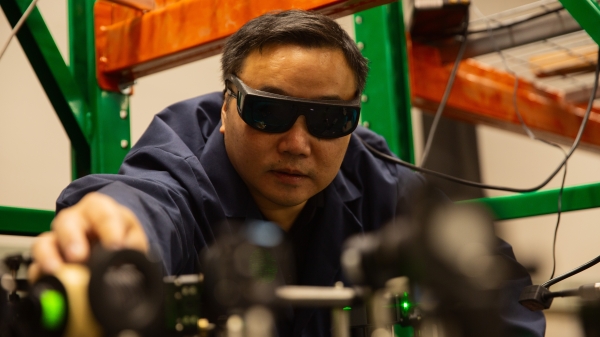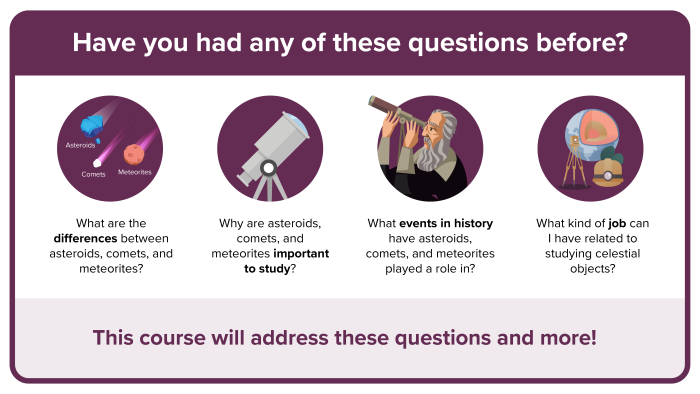9 months into a 6-year journey to a far-flung asteroid, NASA's Psyche mission cruising along

Comet C/2020 F3 (NEOWISE) is seen in the pre-dawn skies on July 9, 2020 over Deer Valley, Utah.
Photo by NASA/Bill Dunford
These days, Lindy Elkins-Tanton is living out a Talking Heads song lyric: She’s keeping her feet on the ground and her head in the sky.
Elkins-Tanton, principal investigator of the Arizona State University-led NASA Psyche mission, is carefully monitoring the Psyche spacecraft as it cruises 2.2 billion miles toward an asteroid by the same name with an expected arrival date of August 2029. The team has hypothesized that the metal-rich asteroid is core material of a planetesimal, a building block of an early planet. Studying it may give us insight into how Earth and the other terrestrial planets formed.
While she’s keeping tabs on the spacecraft, Elkins-Tanton is also enthused about a new eight-hour online course she helped develop called “Countless Worlds in our Solar System: Asteroids, Comets and Meteorites.”
The class, hosted by ASU’s Career Catalyst, will examine the small objects that provide insight into the formation of the solar system. It will also answer several questions, such as:
- What are the differences between asteroids, comets and meteorites?
- What events in history have asteroids, comets and meteorites played a role in?
- What kind of jobs can one get studying celestial objects?
“We humans can’t resist. We’re still really focused on the planets,” said Elkins-Tanton, who is also a Regents Professor in the School of Earth and Space Exploration and vice president of ASU’s Interplanetary Initiative.
“We’ve been thinking about these planets that we’ve been able to see for thousands of years, and only now are we learning about how many more small objects there are all through the solar system and what they mean for what the solar system is, how it formed and what it’s made of.
“So, helping more people learn about the wonders of the unbelievable zoo of things out there is what I’m excited about.”
The course is available to the public at no cost on ASU’s Career Catalyst website. It joins a slate of online courses the mission has developed for its Innovation Toolkit.
The outline for the “Countless Worlds” course came from a resource book Elkins-Tanton wrote called “Asteroids, Meteorites, and Comets.”
Cassie Bowman, Psyche co-investigator and Student Collaborations lead, and Psyche Student Collaborations interns — including Kaxandra Nessi, Kacy Hatfield and Hetvi Patel, among others — helped EdPlus at ASU with the development of the course. Several Psyche team members at ASU — including Elkins-Tanton; Jim Bell, co-investigator, past deputy PI and imager lead; David Williams, co-investigator and deputy imager lead; and collaborators Laurence Garvie and Scott Dickenshied — aided with course content and review.
Additional School of Earth and Space Exploration faculty and staff provided content and feedback, including Jemma Davidson and Devin Schrader from ASU’s Buseck Center for Meteorite Studies, professors Darryl Reano and Steve Semken, and others. And Psyche mission team members from other institutions as well as scientists beyond the Psyche mission contributed through interviews and reviews of materials.
“I had the great pleasure to be on the science team for NASA’s Dawn mission to asteroid Vesta and dwarf planet Ceres prior to joining the NASA Psyche mission,” Williams said. “I learned so much about asteroids and meteorites over the last 15 years, and I enjoy sharing that knowledge with different audiences. I’m so pleased I was able to help with the development of this course.”
The timing of the course is ideal. The Psyche spacecraft is nine months removed from its Oct. 13, 2023, launch from NASA’s Kennedy Space Center in Florida, and is scheduled to make a gravity-assist flyby of the planet Mars in May 2026.
“Results from space missions across the solar system and the study of asteroids, comets and meteorites from telescopes and laboratories are constantly in the news,” Bell said. “We’ve still got a way to go before the Psyche mission starts making asteroid science news. But in the meantime, this course is a great way for students, teachers and others interested in the mission to learn more about not only our mission’s goals, but the important reasons in general why scientists around the world study asteroids, comets and meteorites.”
So far, according to Elkins-Tanton, everything with the mission is going as planned. She added that an earlier checkout of Psyche’s systems and subsystems didn’t reveal any problems.
Get involved
Learn more about the mission at psyche.asu.edu and find a range of resources from the “Countless Worlds” course described in this article to teacher resources to instructions on building your own spacecraft out of paper or Legos.
“The spacecraft has performed spectacularly. It’s just really, really going well,” she said.
Bob Mase, Psyche’s project manager at NASA’s Jet Propulsion Laboratory in Southern California, said that as of early July, the spacecraft was already more than 260 million miles from Earth and traveling at 39,000 miles per hour around the sun.
He said Psyche will be in “cruise mode” for the next year as the electric thrusters propel the spacecraft to the asteroid, adding that the giant solar arrays that power the thrusters are “producing all the power we expected.”
Psyche’s flight team is in contact with the spacecraft every Monday for about eight hours, Mase said, to check in on the health and status, and send up whatever commands are needed. The team also executed a set of maintenance and calibration activities for each of the science instruments earlier this month.
“At this point, the team is focused on ensuring that the spacecraft is healthy and making sure we’re thrusting to get to the asteroid,” he said.
Still, Elkins-Tanton isn’t assuming the rest of the mission will go smoothly as the first months have.
“I would never say that because things can happen at any time,” she said. “... I don’t think the nervousness is quite what it was, but there’s definitely a heightened attention. We have to monitor everything.”
Even though Psyche won’t reach the asteroid until 2029, Elkins-Tanton said the mission team — which at its peak was approximately 800 people and now is around 300 — already is preparing for the data the spacecraft will collect.
“I feel like this is something that maybe is unappreciated,” Elkins-Tanton said, “how critical it is that the team members work together smoothly and have a high degree of trust and understand the process so that when the data starts flowing and there’s controversies and crises, we really know what it is we’re analyzing and how we’re going to interpret the data that we get.
“It’s not a turnkey thing. It’s very human. So, we’re practicing looking at data and interpreting it and not jumping to conclusions. All these things do take practice and bringing them into your conscious mind.”
When Psyche reaches the asteroid in 2029, it will be the culmination of a journey Elkins-Tanton began in 2011 and one that included a yearlong launch delay.
As you might imagine, then, Elkins-Tanton has no problem waiting patiently.
“I think I went through all of my hair-tearing the year before launch,” she said. “So, I think I’m pretty good with the time period.”
More Science and technology

Jackpot! ASU hackers win $2M at Vegas AI competition
This August, a motley assortment of approximately 30,000 attendees, including some of the best cybersecurity professionals, expert programmers and officials from top government agencies packed the…

Why women and LGBTQ+ students face greater challenges in college science classrooms
A new nationwide study conducted by researchers from Arizona State University, titled "Academic social comparison: a promising new target to reduce fear of negative evaluation in large-enrollment…

New technology developments to help surgeons save lives
How many heart surgeries are performed each year worldwide? What about colonoscopies?In the United States alone, more than 900,000 heart surgeries are performed each year. Around the globe, 17.9…
